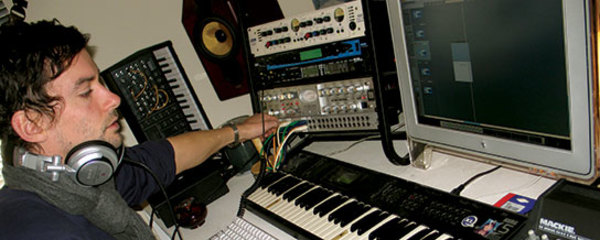Bonobo In the Studio
The music press has birthed a great deal of corny genre names, but perhaps the […]
Bonobo In the Studio
The music press has birthed a great deal of corny genre names, but perhaps the […]

The music press has birthed a great deal of corny genre names, but perhaps the daddy of them all is “chill-out.” Totally functional, and devoid of personality, chill-out does exactly what it says on the tin. But sometimes these labels serve a necessary purpose, aside from selling compilation albums–they help launch careers. Such was the case for Simon Green (a.k.a. Bonobo), who debuted in 1999 with Animal Magic (Ninja Tune), an album that displayed the kind of chill mastery most journeyman ambient producers spend a lifetime chasing.
Since Animal Magic, Bonobo’s music has transcended both chill-out and downtempo. What was once made on just a sampler and mixing desk is now done primarily with live instruments. Bonobo has become his own record collection, sampling his own drums, strings, and whatever else he can think up. Here he fills us in further on his organic cut ‘n’ paste aesthetic.
XLR8R: Did you make any music before Animal Magic?
Simon Green: I was in and out of bands when I was younger, playing all sorts of shit like guitars and drums. But the thing is, there’s always a conflict of interest in bands–it’s that familiar story. So when I moved down to Brighton’ sort of got into what was going on here with the cut ‘n’ paste hip-hop scene. A friend of mine introduced me to samplers, and I picked up an Akai [S950] and an Atari and started playing my guitar and drums straight into the sampler. It was all trial and error.
How has your production method changed over the years?
I play most of the instruments myself–everything except the strings and horns–but it’s still the same process… I still use the sampler, but I’m using my own playing rather than other people’s records. I just got bored of how I was working–looking for a loop, looking for a break, piecing everything together. I wanted to do something a little more challenging, like really writing music… getting into the science of microphones and recording.
What are the challenges of working with organic sounds versus sampled sounds?
I’ve never had any sort of technical training on how to record things, so a lot of it is making things sound right… especially for instruments like bass or strings. I had one microphone [a Rode NT1]. It was kind of a low-end mic and everything just [went] into that. I don’t really have an end result in mind–I just record it and see how it sounds in the end.
Do you layer your instruments with electronic sounds?
It’s hard for me to use any electronic sounds at all, really. I’m always just layering acoustic sounds. Like [with drums], I kind of mix it up [by] using a lot of hand percussion and punctuating it with kicks and snares, and miscellaneous bangs and noises.
How do you record? Do you go through a pre-amp into your computer?
I’ve been using an Avalon [VT-737SP] as a front end. It’s a mono vacuum-tube compressor and EQ, and it’s really nice… I use it for everything. Then the whole thing goes into [Apple] Logic. With the exception of a few reverbs and some other outboard stuff, I’m doing everything with Logic and [Native Instruments] Kontakt.
What’s the hardest thing to record?
I always have trouble recording drums and double bass. I’ve had great sessions where I recorded a drum kit in a big, shaky room with just one mic and it sounded great… and I’ve tried it again, and it just [didn ‘t] sound right. Then I’ve tried the other way where you mic up every drum and EQ it, and it sounded like something from Baywatch.
How do you translate studio creations to a live performance?
When we first started out, we were playing along to the tracks minus the drums, bass, and saxophones. But it didn’t really feel like a live performance–we didn’t have any control. So we stripped all that away, and it gelled. It was a revelation when we decided to turn off the backing track, and just kind of play. That’s when it all started to come together.
Do you ever get stuck on ideas?
I’ve noticed one in five ideas never amount to anything. There are so many things on the loop that never go further than that. But I think the most important thing is to stay with the track. Don’t put it to bed for the night and expect to see it the same way the next morning. If you’re in a current mind state where you know what you want from the track, you can’t just leave it and expect to come back with the same mindset.

